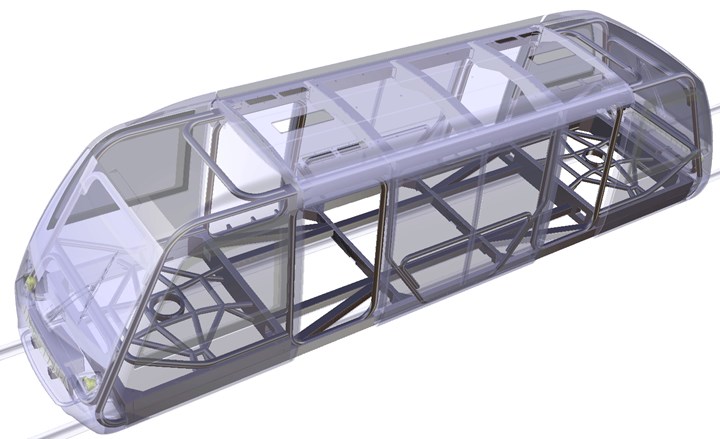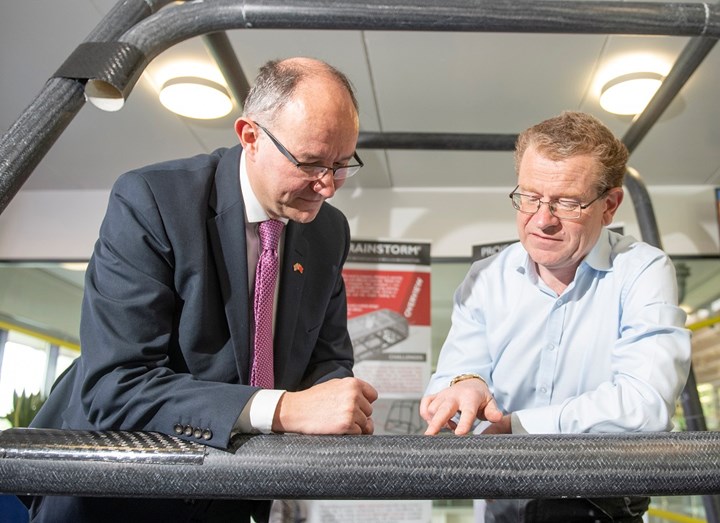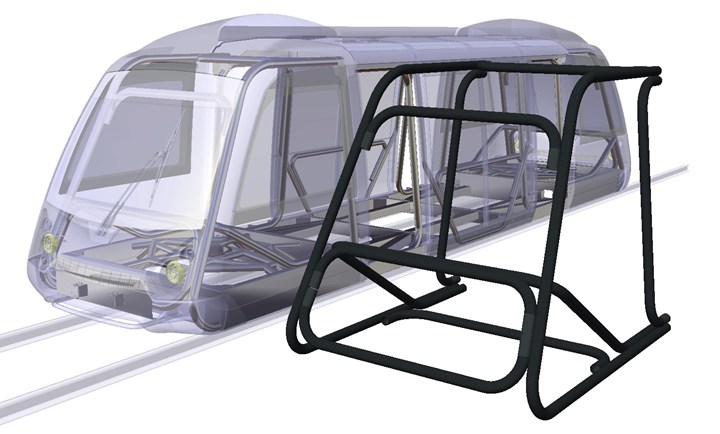WMG prototypes CFRP frame for Very Light Rail (VLR) demonstration vehicle
Braided thermoplastic composite frame enables lightweight, recyclability and high-volume manufacturing.
Revolution VLR is a consortium in the U.K. — led by Transport Design International Ltd (TDI, Stratford upon Avon) — which won funding in 2013 to develop a self-powered rail bogie with an integral, hybrid propulsion system. TDI believes that designing lighter “light rail” vehicles — i.e., very light rail (VLR) — is crucial for providing the next generation of sustainable public transport. In phase 2 of the VLR project, a complete 18-meter-long diesel-battery demonstrator vehicle will be available for testing in 2020.

The Very Light Rail (VLR) demonstrator is an 18-meter-long bogie with integrated diesel-battery hybrid propulsion system and a lightweight chassis made from braided composite tubes. SOURCE | University of Warwick.
An original member of Revolution VLR, has developed a carbon fiber reinforced plastic (CFRP) frame for this demonstration VLR vehicle. WMG is a long-time supporter of composites, with initiatives such as the , the and the WMG’s partners for this “BRAINSTORM VLR” project include TDI, the UK Government’s Innovate UK (which funds composites), lightweight structural composite components developer and . The frame is made from a series of braided thermoplastic composite tubes which are easily assembled via adhesive bonding and simple welding.

The VLR prototype/demonstrator vehicle will use a spaceframe chassis made from braided carbon fiber-reinforced thermoplastic composite tubes which are easily assembled via adhesive bonding and simple welding. SOURCE | University of Warwick.
The tube outside diameters are kept the same, with different load and attachment requirements handled by varying the wall thicknesses. This keeps tooling costs low and means that joins can be standardized. Braiding enables a highly automated manufacturing process — rates for the reinforcement alone can exceed 1 mile/day — as well as a tailorable set of materials, including other fibers (e.g., glass, aramid, thermoplastic) and thermoplastic matrix materials from low-cost polypropylene to high-end polyetheretherketone (PEEK). Meanwhile, WMG has demonstrated a complete molding cycle that can be reduced to less than five minutes, highlighting the potential of this affordable process for high-volume applications.
Braiding enables highly automated manufacturing … a tailorable set of materials … a complete molding cycle that can be reduced to less than five minutes, highlighting the potential of this affordable process for high-volume applications.
Thermoplastics also provide for recyclability, according to David Goodwin, engineering manager at Far-UK. “With composites you can save a lot of weight, which is obviously appealing for the operation of the [rail] car,” he begins, “but with traditional composites, at the end of the car’s life it is simply placed in landfill, which is not ideal. With this [design], there is a route to recycle the car body when it eventually goes out of service, or, alternatively, if it suffers an impact and part of it has to be repaired and replaced.”

University of Warwick
The tubular spaceframe chassis design also aids in this approach, allowing any damage tubes to be simply removed and replaced with a new or repaired one. “Our BRAINSTORM VLR research partnership has achieved significant weight-saving, allowing VLR services to accommodate more passengers while reducing the energy required to propel the vehicle and the weight stress it will place on its rails and road surface,” explains Dr. Darren Hughes, associate professor in Materials and Manufacturing at WMG University of Warwick. “The technology also ensures that the vehicle is tough for a long life in service, easily repairable when accidents happen and strong enough to protect the passengers on board.”
“The BRAINSTORM Project feels like a real step forward to the team at Far Composites,” says Far-UK director and general manager Lyndon Sanders. “Being able to tap into the industry experience of TDI to hone the principle of a new type of body structure for mass transit applications was great. Add to that the collaborative working with Composites Braiding and WMG to turn that thinking into a physical demonstrator to show what it would be like in practice was really powerful. Now it’s more than a good idea, it’s an eye opener for industry players who can see it, touch it and even pick it up.”
Related Content
Plant tour: Teijin Carbon America Inc., Greenwood, S.C., U.S.
In 2018, Teijin broke ground on a facility that is reportedly the largest capacity carbon fiber line currently in existence. The line has been fully functional for nearly two years and has plenty of room for expansion.
Read MoreCarbon fiber, bionic design achieve peak performance in race-ready production vehicle
Porsche worked with Action Composites to design and manufacture an innovative carbon fiber safety cage option to lightweight one of its series race vehicles, built in a one-shot compression molding process.
Read MoreCutting 100 pounds, certification time for the X-59 nose cone
Swift Engineering used HyperX software to remove 100 pounds from 38-foot graphite/epoxy cored nose cone for X-59 supersonic aircraft.
Read MoreBladder-assisted compression molding derivative produces complex, autoclave-quality automotive parts
HP Composites’ AirPower technology enables high-rate CFRP roof production with 50% energy savings for the Maserati MC20.
Read MoreRead Next
Next-gen fan blades: Hybrid twin RTM, printed sensors, laser shock disassembly
MORPHO project demonstrates blade with 20% faster RTM cure cycle, uses AI-based monitoring for improved maintenance/life cycle management and proves laser shock disassembly for recycling.
Read MoreScaling up, optimizing the flax fiber composite camper
Greenlander’s Sherpa RV cab, which is largely constructed from flax fiber/bio-epoxy sandwich panels, nears commercial production readiness and next-generation scale-up.
Read MoreCeramic matrix composites: Faster, cheaper, higher temperature
New players proliferate, increasing CMC materials and manufacturing capacity, novel processes and automation to meet demand for higher part volumes and performance.
Read More












